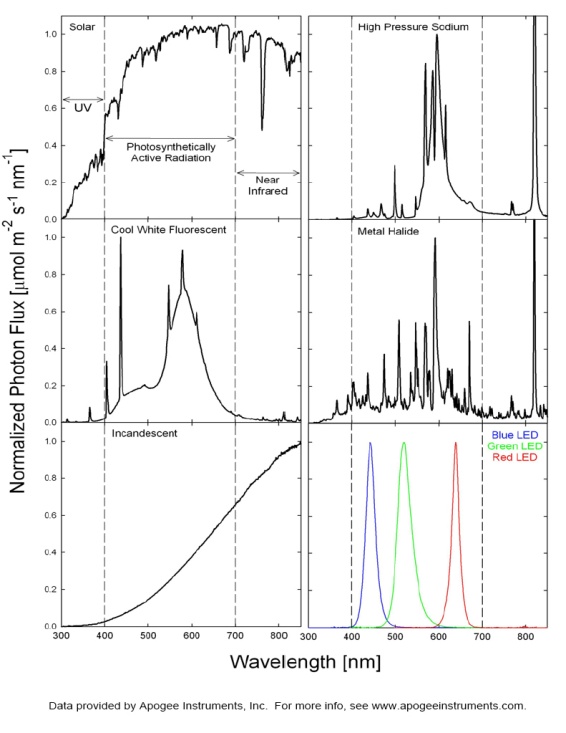Apogee offers quantum sensors that are calibrated for either sunlight or electric light. The reason for this is due to the significant differences in spectral output among light sources. The following graphs illustrate those differences.
Here at Apogee, our quantum sensors for electric lighting are calibrated under high output T5 fluorescent lamps. The above differences in response indicate that there will be differences in sensor output if it does have a perfect spectral response. While the difference in calibration is less than 10% between electric light calibration (T5s) and sunlight calibration, it is also important to note the differences between T5 and other common electric light sources. The following table summarizes differences among lamp types.
-->
Light Source
|
Electric Calibration
|
Sunlight Calibration
|
T5 Fluorescent
|
Calibration Reference
|
9.1% High
|
T12 Fluorescent
|
2.2% low
|
6.9% high
|
Metal Halide
|
1.7% low
|
7.4% high
|
High Pressure Sodium
|
6.2% low
|
2.9% high
|
Sunlight
|
9.1% low
|
Calibration Reference
|
In the end, all quantum sensors will have imperfections in their spectral response, and thus will introduce errors. Unfortunately, science rarely if ever has the convenience of working in absolutes.
A note on LED lighting: due to the imperfect spectral response of all quantum sensors and meters, these broadband sensors are less accurate for measuring the narrow spectral output of some LEDs. Quantum sensors can accurately measure broad-spectrum white LEDs, however. Quantum sensors can be used to provide a relative output of LEDs over time and temperature, but they can have errors of over 20% for some narrow wavelength LEDs. A spectroradiometer is the most accurate instrument for characterizing the absolute PPF of narrow band LEDs.
Jacob Bingham
Applications Engineer



Hey Jacob,
ReplyDeleteThanks a ton for that information. I'm very interested in LED grow lights and have been wondering about using a Quantum sensor to measure their output.
You mentioned that "Quantum sensors can be used to provide a relative output of LEDs over time and temperature." Do you have any tips for how to use these sensors on LEDs to get the best possible reading?
I'm hearing that spectroradiometers are like $5,000 so I'd rather go with a Quantum sensor if possible.
Best,
Nate J.
johnson.nate21@yahoo.com
Please email me back or just write a response here on your blog.
As a less accurate method you can use the same spectral response graph as mentioned above to get a relative idea of the error – the graph can also be found on our website (http://www.apogeeinstruments.com/quantum/spectralresponse.html). For example, when measuring a 450 nm blue LED the Apogee quantum sensor will have a relative quantum response of approximately 0.8. Therefore, you can figure that the photon flux reading from the sensor is reading approximately 20% low. Just remember, this approach is only relative so you would still need to give yourself a wide margin of potential error. We are planning on performing some quantitative measurements of various LEDs in the coming weeks, so please check back for those results.
ReplyDeleteThanks,
Jake
Jake,
ReplyDeleteThat is extremely helpful. I really appreciate the time you took to write that up.
I'll definitely be back to see your LED results. This blog has been very helpful.
Nate